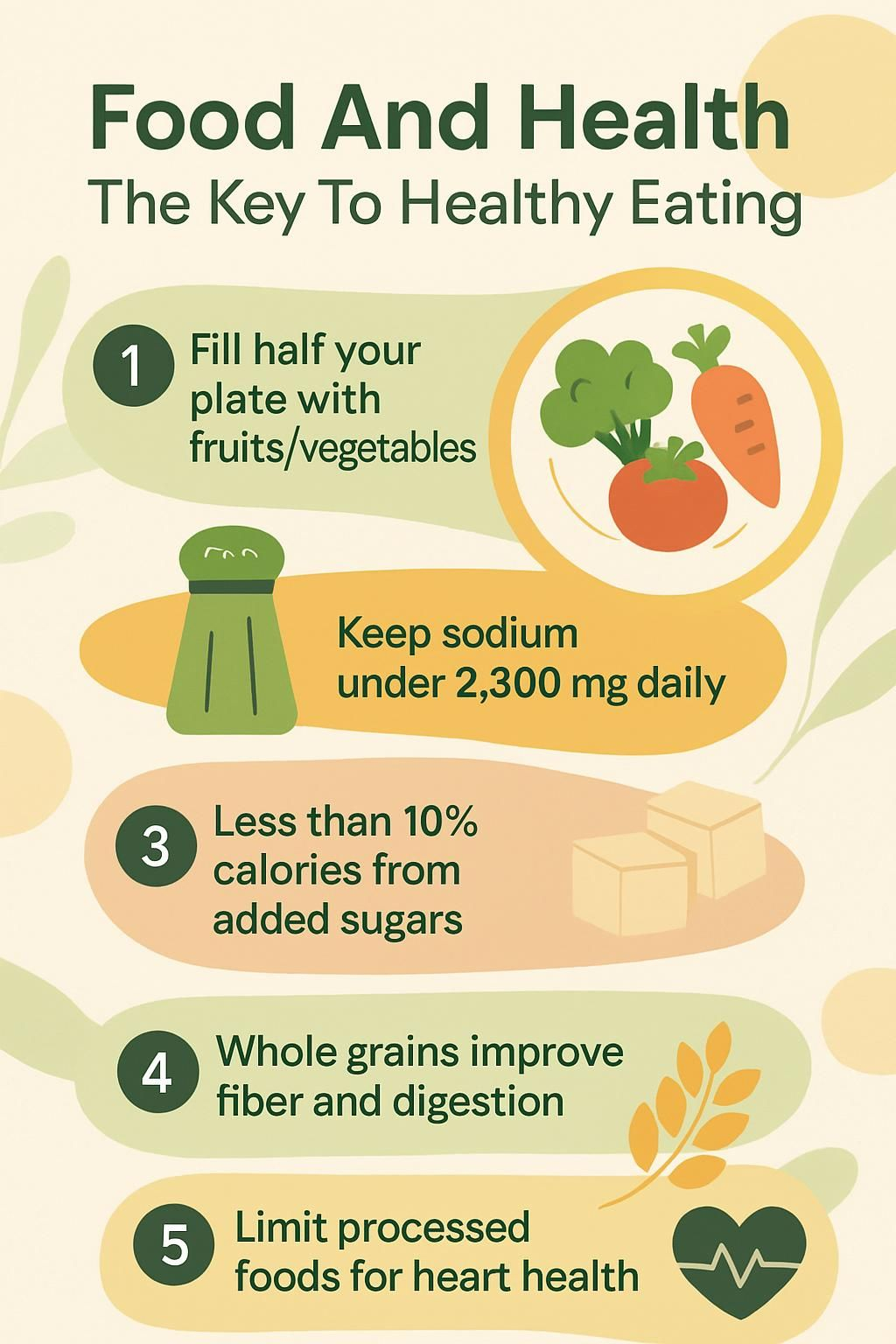Food And Health: The Key To Healthy Eating
Our Nutrition Assistant AI Suite will transform your body. You will lose fat, get toned, and build muscle. Gain confidence and optimal health.
Healthy eating can feel hard when quick snacks are everywhere. Much of that food is high in fat, sugar, and salt. Your daily choices add up. A healthy diet lowers your risk of heart disease, type 2 diabetes, and obesity. This guide shares simple eating tips, explains key nutrients in plain language, and highlights updates from the Dietary Guidelines for Americans so you can build steady habits that stick.
Small steps today support better energy, mood, and long-term health. Learn how smart food choices shape your well-being.
Key Takeaways
- The Dietary Guidelines for Americans, 2020-2025 suggest filling half your plate with fruits and vegetables and keeping sodium under 2,300 mg per day.
- Healthy eating lowers risk for chronic diseases such as heart disease, type 2 diabetes, and obesity. Aim for less than 10% of daily calories from added sugars and saturated fat.
- Whole grains, such as brown rice and oats, provide more fiber than refined grains, support digestion, and help steady blood sugar.
- Key nutrients like vitamin D, calcium, potassium, and protein from dairy, lean meats, beans, and leafy greens support immune function and bone strength (USDA/NCHS 2022).
- Limiting processed foods reduces sodium intake, more than 70% comes from packaged foods, and supports heart health and weight management, according to the American Heart Association.

The Relationship Between Food and Health

What you eat shapes how you feel today and how healthy you stay over time. The right fuel supports energy, focus, and disease prevention.
Why is nutrition important for overall well-being?
Nutrition gives your body essential nutrients. These include vitamins, minerals, carbohydrates, proteins, and fats. Each one has a job. Vitamins and minerals support immunity and bone strength. Carbohydrates provide energy. Proteins build and repair tissues. Fats help with hormones and vitamin absorption.
The United States Department of Agriculture encourages eating a variety of foods from all food groups each day. This helps you meet daily targets for key nutrients. People who follow healthy guidelines often report steadier energy and better focus.
I once switched from processed snacks to whole grains and fresh fruit during exam season. My concentration improved and the headaches faded. Smart choices today protect your long-term health.
How do food choices impact health short-term and long-term?
Food choices influence your body within hours and across years. Meals high in saturated fat, added sugars, and salt can spike blood pressure and blood sugar the same day. Frequent soft drinks and ultra-processed snacks can leave you sluggish.
Choosing vegetables, whole grains, and lean proteins supports steady energy. Over time, eating too much saturated fat increases the risk of obesity, hypertension, type 2 diabetes, cardiovascular disease, stroke, and some cancers. Diets high in sodium and low in potassium raise the risk of high blood pressure, the American Heart Association notes.
Families that add more fruits and vegetables often see better heart health and stronger immune function. Using MyPlate with my child improved attention at school and calmer moods at home. Healthy choices today reduce the chance of chronic conditions later.
Key Nutrients and Their Functions
Key nutrients help your immune system and keep your body working smoothly. Each nutrient plays a role in everyday health.
How do vitamins and minerals support immunity and metabolism?
Vitamins and minerals support your immune system and metabolism, the process that turns food into energy. Vitamin C, found in oranges and peppers, helps your body make white blood cells. Zinc supports wound healing and infection defense. Calcium and vitamin D work together for strong bones, especially as you age. Potassium balances fluids and supports nerves and muscles.
Build a daily mix with leafy greens, milk or fortified alternatives, potatoes, beans, and fruit. Many people in the United States fall short on calcium, vitamin D, and potassium, according to 2022 data from the National Center for Health Statistics. After I addressed my own nutrient gaps, I noticed better energy and fewer colds.
“Fruits and vegetables are vital sources of vitamins, minerals, dietary fiber, plant protein, and antioxidants.”
Eating a variety of these foods supports a healthy metabolism and lowers the risk of heart disease and stroke.
What role do carbohydrates play in providing energy?
Carbohydrates are your body’s main energy source. Common staples such as wheat, rice, maize, barley, and starchy vegetables like potatoes, yams, taro, and cassava provide most carbs. Whole grains offer longer-lasting fuel because their fiber slows digestion and supports blood sugar control.
Nutrition experts advise making at least half your grains whole to support digestion and reduce the risk of metabolic syndrome over time[1]. Choosing whole grains and limiting high-sugar foods can help active families and children at risk for childhood obesity stay energized without extra calories.
Reference:
[1] U.S. Department of Health & Human Services, Dietary Guidelines for Americans 2020-2025
How do proteins help build and repair tissues?
Protein builds and repairs tissues in muscles, skin, organs, and hair. After activity or minor injuries, protein helps repair tiny muscle tears. Good sources include lean meats, seafood, eggs, legumes, soy products, nuts, and seeds. You can also get protein from animal sources such as milk, chicken, and fish.
The Dietary Guidelines for Americans suggest including a variety of protein foods each week. Adequate protein supports muscle strength as you age or if you spend long hours sitting. People managing type 2 diabetes or aiming to improve body mass index also benefit from protein-rich choices.
Meeting your protein needs supports recovery and lowers the risk of malnutrition.
How do fats regulate hormones and nutrient absorption?
Fats help your body regulate hormones such as insulin, estrogen, and testosterone. Healthy fats, like polyunsaturated and monounsaturated fats found in vegetable oils, nuts, and fish, support hormone balance and metabolism. Fats also help your body absorb vitamins A, D, E, and K. These are called fat-soluble vitamins.
Saturated fats, common in butter, ghee, lard, coconut oil, and palm oil, can raise heart disease risk if you eat them often. National guidelines suggest limiting total fat to about 30 percent of daily calories. Choosing mostly healthy fats supports hormones and nutrient absorption.
Benefits of Healthy Eating
Healthy eating protects your body, supports focus, and can prevent many diet-related conditions such as heart disease and stroke.
How does healthy eating reduce the risk of chronic diseases?
Filling your plate with vegetables and fruit can help prevent unhealthy weight gain. That lowers the risk of many chronic diseases, including heart disease and stroke. Limiting saturated fat, trans fat, salt, and added sugar also reduces the risk of diabetes and certain cancers.
For instance, keeping salt under about 5 grams per day helps prevent high blood pressure, a major driver of cardiovascular disease, the World Health Organization reports. Swapping sugary drinks for water and choosing fresh produce over syrupy snacks support long-term health. During college, I made these swaps and saw more steady energy and better cholesterol at checkups.
Small changes each week lead to meaningful gains for your well-being.
How can healthy eating help maintain a healthy weight?
Choosing nutrient-dense foods makes it easier to manage daily calories. Fiber-rich foods, such as fruits, vegetables, whole grains, legumes, nuts, and seeds, keep you full longer. Eating fewer added sugars and fewer processed items lowers the chance of weight gain.
Portion control and mindful eating help prevent overeating. The DASH diet, for example, focuses on portion guidance and nutrient-dense foods to support calorie control. Consistency is key. Healthy routines make weight goals more realistic without extreme restrictions.
What are the effects of healthy eating on mental health and cognitive function?
A diet rich in fruits and vegetables supplies vitamins, minerals, and antioxidants that protect the brain. This can boost mood and sharpen focus. Vitamin C from oranges or sweet potatoes helps manage stress. Leafy greens provide folate, which supports steady energy.
Limiting added sugar and unhealthy fats may reduce mood swings and daytime fatigue. Many people notice better performance at school or work after choosing nutrient-dense foods more often. Fish, eggs, nuts, whole grains, and a small square of dark chocolate can support brain health.
How does healthy eating strengthen immunity, bones, and teeth?
Nutritious food supports your immune system and strengthens bones and teeth. Calcium and vitamin D are key for bone health and help prevent osteoporosis. You can get them from dairy products, fortified foods, and leafy greens. Potassium supports heart, kidney, muscle, and nerve function.
A variety of vitamins and minerals, found in produce like yams and many other vegetables, work together to protect against illness. Good nutrition supports short-term defenses and lifelong strength.
Components of a Healthy Diet
A healthy diet provides the nutrients your body needs each day. Understanding diet means learning how different foods support your health.
How can you incorporate more fruits and vegetables?
Add fruits and vegetables to every meal in simple ways. Keep sliced carrots, cucumbers, or yam sticks for quick snacks. Top cereal or yogurt with berries and a spoon of pumpkin seeds or almonds. Swap dessert with a piece of fruit or add fruit to your breakfast plate.
Mix chopped tomatoes and herbs into sauces, salads, and soups. Layer sandwiches with leafy greens, peppers, and cucumbers. The Dietary Guidelines for Americans suggest most adults aim for at least five servings daily. Prepping containers of produce made snacking easier for me and boosted my fiber intake.
Why choose whole grains over refined grains?
Whole grains supply more fiber and nutrients than refined grains. Starting your day with oatmeal is an easy win. Bulgur, quinoa, and brown rice offer vitamins and minerals that support immunity and metabolism. Whole grains also help regulate blood sugar, which can reduce dyslipidemia, unhealthy blood fat levels.
Make simple swaps. Try brown rice instead of white. Use bulgur in salads. Choose 100% whole-wheat bread. For me, oats at breakfast kept me full longer than white bread. Whole grains help you get steady energy and essential nutrients that support bone health and overall wellness.
What are good lean protein sources?
Seafood, lean meats, poultry, eggs, legumes, soy products, nuts, and seeds are strong protein choices. Beans, lentils, and sardines add iron and omega-3 fats. Low-fat yogurt or avocado can replace whole milk in smoothies to reduce saturated fat. Choose beans or fish instead of processed meats like sausage or bacon to support heart health.
I once swapped sausage for grilled chicken in a salad. I felt full longer without the extra saturated fat. Eggs and sardines provide vitamin D for bone health, and soy products offer a plant-based option.
How can you limit sugar, saturated fats, and processed foods?
After choosing lean proteins, lower added sugar, saturated fats, and processed foods. Pick water or unsweetened drinks instead of sugary beverages. Try to keep added sugar under 10% of daily calories. Even lower, below 5%, brings extra benefits.
Replace saturated fats with oils like olive, canola, soybean, sunflower, peanut, or safflower. More than 70% of dietary sodium comes from packaged and prepared foods, so read Nutrition Facts labels and choose lower-sodium options. I had trouble avoiding processed snacks until I started cooking simple vegetable and yam dishes at home.
Small, steady changes make a big difference.
Healthy Eating Habits
Daily habits drive progress. Simple routines can lift energy and support your body’s defenses.
Why is portion control important?
Portion control prevents overeating and supports weight maintenance. Tools like MyPlate show how to split your plate by food group. Managing serving sizes helps control calories and lowers risk for obesity, heart disease, and diabetes.
Using visual cues, hand guides, or measuring cups can help until you learn what typical portions look like. Consistent portion control leads to better decisions at meals and healthier outcomes.
Quick recap: Portion control supports weight goals and reduces disease risk by keeping calories in check.
How much water should you drink daily?
About 8 cups, or 64 ounces, of water a day works well for most people. Water supports digestion, metabolism, and temperature control. It also helps you manage calories by replacing sugary drinks that add energy without fullness.
Choose water over soda or juice. Add citrus or berries for flavor without added sugars. Many people notice clearer thinking and more stable energy when they stay hydrated.
How do you plan balanced meals?
Use MyPlate as a simple template. Fill half your plate with fruits and vegetables. One quarter is for whole grains, such as brown rice or whole-wheat bread. The last quarter is for lean proteins like poultry, fish, beans, or tofu. Include a serving of low-fat dairy such as milk or yogurt.
Try the Start Simple with MyPlate app to track your food group goals. Cooking more at home lets you control ingredients and portions. Vary your choices each week so you get a wide range of nutrients.
Why should you avoid skipping meals?
Skipping meals often leads to overeating later and less healthy decisions. People who skip breakfast tend to eat more overall, which increases the risk of weight gain and metabolic issues.
Regular meals keep energy steady and help you meet nutrient needs. During college, I felt unfocused on days I skipped lunch. A consistent meal routine improved my mood and performance. Aim for balanced meals that cover several food groups.
Dietary Guidelines for Americans
The Dietary Guidelines for Americans provide science-based advice for all ages. Use them as a steady map for healthy eating.
What are the recommended food groups and servings?
Healthy eating means choosing the right foods and the right amounts. MyPlate and the Dietary Guidelines for Americans, 2020-2025 offer clear direction:
- Fill half your plate with fruits and vegetables. Eat whole fruits and vary your veggies each day. MyPlate encourages you to aim for at least 2 cups of fruits and 2.5 cups of vegetables daily for adults.
- Make grains a key part of your meals. At least half should be whole grains, such as brown rice, oats, or whole-wheat bread. Adults should aim for 6 ounce-equivalents of grains each day.
- Include protein with every meal. Choose lean meats, chicken, fish, eggs, beans, peas, soy products, or nuts. Adults need about 5 to 6.5 ounce-equivalents of protein foods per day.
- Choose dairy or fortified soy beverages for bone health. Select fat-free or low-fat milk, yogurt, or cheeses. The recommendation is 3 cups per day for adults.
- Limit added sugars, saturated fats, and sodium. The guidelines urge you to stay under 10% of total daily calories for both added sugars and saturated fat, and keep sodium below 2,300 mg per day.
- MyPlate helps personalize your portions based on age, sex, and activity level. Pregnant women, infants, teens, and older adults can all find specific advice on the MyPlate website.
- Variety matters as each food group supplies unique nutrients. Eating across all five groups, fruits, vegetables, grains, protein foods, and dairy, supports balanced nutrition and long-term health.
Why reduce salt, sugar, and unhealthy fats?
Too much salt, sugar, and unhealthy fats raises disease risk. Keeping sodium closer to 2,300 mg per day helps control blood pressure. Limiting added sugars to under 10% of daily calories reduces the chance of weight gain and diabetes. I once tracked my snacks and replaced candy with fruit. Energy and focus improved within a week.
Saturated fat can raise LDL cholesterol, which increases heart disease risk. Replacing saturated fats with unsaturated fats supports heart health. Keeping total fat near 30% of daily calories helps prevent weight gain and cardiovascular problems.
Challenges to Healthy Eating
Barriers are real, from tight budgets to busy schedules. A few practical moves can keep you on track.
How do budget constraints affect healthy eating?
High food prices push many people to pick cheaper, processed options. Those foods often contain more salt, sugar, and unhealthy fats. Cooking at home with basic ingredients can save money and improve nutrition.
Tools like Shop Simple with MyPlate and MyPlate Kitchen offer low-cost recipes and shopping tips. Buying seasonal produce can lower costs and improve freshness. You can also search recipes by ingredient to use what you already have, such as beans or rice.
How can busy lifestyles impact food choices?
Busy days lead to quick choices like packaged and prepared foods. These items often contain high sodium and unhealthy fats. More than 70% of dietary sodium comes from packaged and prepared foods, which raises blood pressure risk.
Meal planning helps. Try setting goals with the Start Simple with MyPlate app. Batch-cook grains and proteins on weekends. Prepack vegetables and fruit for grab-and-go snacks. A few minutes of planning reduces last-minute fast food.
What are common nutrition misinformation issues?
Labels on packages and viral posts can mislead. A product marked “natural” or “low-fat” is not always nutritious. Extreme diets that promise fast weight loss rarely have strong science behind them.
Look for reliable sources such as the USDA, CDC, and WHO. Reading Nutrition Facts labels can reveal hidden sugars and sodium. I discovered my go-to deli turkey had about 500 milligrams of sodium per serving. Switching to a lower-sodium brand helped me meet daily limits.
Tips for Making Healthy Food Choices
Simple strategies make daily choices easier. Start with labels, plan ahead, and shop smart.
How do you read and understand food labels?
Begin with the serving size. All the numbers on the label match that serving. If you eat double the serving, you double the calories, sodium, sugar, and fat.
Check added sugars and sodium next. Added sugars include names like cane juice, corn syrup, dextrose, fructose, maple syrup, honey, or table sugar. High-sodium items often include breads, pizza, and deli meats. I started checking labels and found better lower-sodium choices without losing flavor.
Reading labels helps you choose products with less sodium, less added sugar, and healthier fats.
What are the benefits of meal prepping?
Meal prepping gives you control over ingredients and portions. Cooking at home helps limit sodium and processed items. Planning ahead makes it easier to include fruits, vegetables, and whole grains during the week.
Prepping saved me time and money during busy weeks and improved my energy. USDA findings show that people who plan meals tend to eat more fiber, vitamins, and minerals[1]. Keeping ready-to-go meals in the fridge makes school or work lunches simple.
…
[1] USDA Economic Research Service: “Food-at-Home Meal Preparation (June 2022)”
Why shop for seasonal and local produce?
Seasonal and local produce often costs less and tastes better. It usually has higher nutrient levels because it spends less time in transport and storage. The Shop Simple with MyPlate tool can help you find good deals nearby.
Farmers’ markets and local stores offer produce picked at peak ripeness. Studies show fruits and vegetables lose nutrients the longer they travel or sit on shelves^1. Buying in season supports your community and keeps meals colorful and varied.
…
^1 Rickman JC, Barrett DM, Bruhn CM (2007). Nutritional comparison of fresh, frozen and canned fruits and vegetables II. J Sci Food Agric. 87(6):1185-1196.
Innovations in Nutrition and Food Science
New research gives you more ways to meet nutrient needs. Some options can fill common gaps in the American diet.
What are functional foods and their health benefits?
Functional foods offer benefits beyond basic nutrition. These include items fortified with nutrients such as calcium and vitamin D to support bones. Examples include fortified soy beverages, yogurts, and cereals.
These foods can help fill nutrient gaps that many people miss. Including them in your routine is a practical step toward meeting daily goals for vitamins and minerals.
What are polyphenol-polysaccharide complexes in plant-based diets?
These complexes occur in many plant foods. Polyphenols are plant antioxidants. Polysaccharides are long-chain carbohydrates such as fiber and starch. Together, they may increase antioxidant activity and lower disease risk.
Apples, oats, berries, beans, and quinoa are rich sources. After adding more colorful vegetables, beans, and whole grains to my meals, I felt more energized. Experts suggest that regular plant-based meals can support immune health and reduce inflammation.
How is personalized nutrition advancing health?
Personalized tools like MyPlate and the MyPlate Quiz offer guidance based on your age, health, and activity level. These tools can be especially helpful if you have medical conditions or food allergies.
As someone with a nut allergy and a busy school schedule, I used MyPlate to plan balanced meals without nuts and track progress. More people now use these tools to learn which nutrients they need most each day.
Always consult a healthcare professional or registered dietitian for personal medical advice. Digital tools guide daily choices. Clinical care helps address specific conditions.
The Role of Physical Activity in Complementing a Healthy Diet
Food fuels your body, and movement uses that fuel well. Together, they support a healthy, active life.
What are the benefits of combining diet and exercise?
A balanced diet plus regular physical activity can cut the risk of type 2 diabetes and heart disease by up to 80%. Nutrient-rich foods support bones, mood, and clear thinking. Exercise helps your body use those nutrients and burn calories.
Many people notice higher energy and better focus during school or work. The CDC reports that children who eat well and are active for at least an hour a day often earn better grades than peers with less healthy habits.
What are the recommended levels of physical activity?
Most adults should aim for at least 150 minutes per week of moderate-intensity activity, such as brisk walking or cycling. Add muscle-strengthening exercises on two or more days weekly for extra benefits.
Children and teens ages six to seventeen need at least 60 minutes of moderate to vigorous activity daily. The Start Simple with MyPlate app can help families set goals and track progress. Making it a shared challenge kept me moving and more consistent.
Health Risks of Unhealthy Eating
Poor eating patterns can lead to serious problems. Knowing the risks helps you choose better options each day.
How does unhealthy eating lead to obesity and weight gain?
Processed foods and sugary drinks raise calorie intake without bringing much nutrition. Frequent large portions and skipping meals can trigger overeating later. Diets high in added sugars and unhealthy fats raise obesity risk, according to the CDC.
One can of regular soda has about 39 grams of sugar, roughly 150 empty calories. During a busy semester, I turned to fast food and gained weight quickly. Switching to nutrient-rich meals helped me feel full longer and manage my weight.
When calorie intake stays high, the body stores the extra energy as fat. Children and adults who snack often on sugary items face higher obesity rates than those who choose balanced meals.
What health risks increase with poor diet, like diabetes and heart disease?
Poor diet raises the risk of type 2 diabetes, heart disease, and stroke. High sodium intake increases blood pressure and can lead to heart attacks or strokes. Diets low in fiber, calcium, vitamin D, and potassium are linked with higher disease rates.
Excess sugar and saturated fat promote weight gain and harm blood vessels. The CDC reports that more than 37 million Americans have diabetes, with poor diet as a key factor. Prioritizing nutrient-dense foods protects against these conditions.
How does unhealthy eating affect mental health and energy?
Diets high in added sugar and unhealthy fats can cause mood swings and mental fatigue. Many people notice trouble concentrating when nutrition is poor. Low intake of vitamins and minerals weakens the immune system and leaves you drained.
Skipping balanced meals lowers energy for school, work, and daily tasks. Eating well strengthens the mind and body at the same time.
The Importance of Nutrition Education
Good information leads to better choices. Clear guidance helps cut through hype and confusion.
How can nutrition education raise awareness about healthy choices?
Nutrition education from trusted sources helps you understand food groups and nutrient needs. The USDA and MyPlate provide tools like the MyPlate Quiz and the Start Simple with MyPlate app. These tools teach portion sizes, label reading, and smart swaps.
I attended a MyPlate workshop at a community center. Learning to add vegetables and choose whole grains improved both energy and mood. Reliable education lessens the pull of fad diets and keeps you focused on evidence-based habits.
Why encourage mindful eating habits?
Mindful eating means paying attention to your hunger and fullness signals. It also means noticing flavors and textures. This practice helps prevent overeating and supports weight maintenance.
Studies show that mindful eating encourages people to eat only when hungry[^1]. I used to eat fast without thinking and often felt overly full. Slowing down improved comfort and enjoyment. Adults who use mindful eating patterns are less likely to develop unhealthy food behaviors^2^.
Next, see how nutrition needs shift with age and health status.
…
[^1]: Harvard T.H. Chan School of Public Health (2020). “Mindful Eating.”.
^2^: CDC National Health Interview Survey 2022: “Nutrition Behaviors Among U.S. Adults.
Personalized Nutrition for Individual Needs
Nutrition needs change with age, activity level, and medical conditions. The right plan should match your life.
How do dietary needs vary by age and health condition?
Infants and toddlers need more fat for brain development. Teens need extra iron and calcium for growth and bones. Pregnant women need enough folic acid and protein to support fetal development. Older adults may require more vitamin D and B12 due to lower absorption with age.
Health conditions also matter. People with diabetes should manage carbohydrates, especially portion sizes and timing. Those with heart disease should limit saturated fat and sodium. The Dietary Guidelines for Americans provide life-stage advice and special guidance for pregnancy and chronic illness.
When should you consult healthcare professionals for nutrition advice?
Seek a registered dietitian or healthcare professional if you live with a chronic condition such as diabetes, heart disease, or gastrointestinal disorders. Get help if you notice unexpected weight loss, fatigue, food intolerance, or signs of nutrient deficiency. Needs also change with pregnancy, aging, or certain medications.
A personalized plan can make eating healthier and more sustainable. I met with a dietitian after frequent stomach pain. Their simple changes eased symptoms within weeks. Professional advice helps you adapt the guidelines to your life.
Conclusion
Healthy eating shapes your future. Choose fruits, vegetables, lean proteins, and whole grains to support immunity and energy. Keep added sugars, sodium, and saturated fat in check to lower the risk of heart disease and type 2 diabetes. Balanced meals also support mood and focus.
Use the Dietary Guidelines for Americans and MyPlate to guide portions and variety. If you have medical concerns, get advice from a healthcare professional. Small steps, repeated daily, lead to lifelong wellness.
FAQs
1. What is the connection between food and health?
Eating a balanced diet supports good health. Nutritious foods provide vitamins, minerals, protein, fiber, and healthy fats that help your body work well. Research shows people who eat more fruits, vegetables, whole grains, lean meats like chicken or fish, and legumes have lower rates of heart disease and diabetes (Harvard T.H. Chan School of Public Health). Choosing nutrient-rich meals helps maintain energy levels throughout the day.
2. How can I start eating healthier every day?
Begin with small changes such as adding an extra serving of leafy greens to lunch or swapping soda for water at dinner. Reading nutrition labels helps you pick foods lower in added sugar and salt. Planning meals ahead makes it easier to include a variety of food groups each week.
3. Which nutrients are most important for a healthy diet?
Key nutrients include protein for muscle repair; calcium from dairy products or fortified plant drinks for strong bones; iron from beans or poultry for oxygen transport; vitamin C from citrus fruit for immune support; fiber from oats or lentils for digestion; and omega-3 fatty acids found in salmon or walnuts which benefit heart function (U.S. Department of Agriculture).
4. Can personal experience help guide better eating habits?
Personal stories often highlight practical steps toward healthier choices such as preparing home-cooked dinners instead of fast food several times per week. For example, after tracking my own meals using a simple journal I noticed fewer headaches when I ate less processed snacks and included more fresh produce daily.
Summary: Healthy eating means choosing varied foods rich in key nutrients while limiting added sugars and sodium content based on evidence-based guidelines supported by research institutions like Harvard University and USDA reports.







